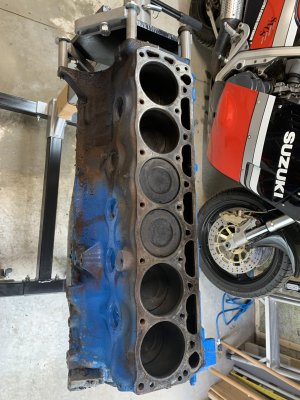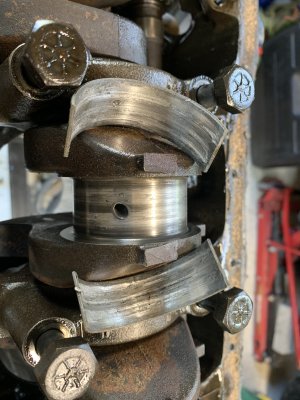Well, I finally got the time to pull the inline 6 200 engine out of my 66 Mustang Sprint. Time to post my experiences for better or for worst.
I bought the car in December 2023 after several years looking for a Mustang or Falcon with an inline 6 200 with manual transmission. My rationale was that being an inline 6, it would have been less abused than a 289 and I like the simplicity of the inline 6. Maybe add some boost. It’s definitely getting a 5-speed and some brakes and suspension.
So the engine… The previous owner hadn’t driven the car in 4 or 5 years. He said he added a pertronix ignition, plugs, oil filter, etc… but it never ran right. Factory carb, factory distributor, factory exhaust manifold and single exhaust. I did some prep, oiled the bores, check the oil, check the antifreeze, fresh gas, new battery, wired the pertronix through a relay to +12v and it fired right up. Idle was a bit rough but good enough to drive up and down the street. It seemed fine so I parked it and considered my next steps to get the car roadworthy (check brakes, suspension, minor bodywork, leaky cowl, etc…).
One day I fired it up to do some tuning and it made some screeching noises so I shut it down to investigate. It stopped abruptly. I thought maybe the water pump or alternator bearings were the issue. It seems the harmonic balancer is really close to the timing chain cover and might be rubbing there or at the oil pan. I can’t really tell but when I went to crank the engine, it was not going to move. I tried with a breaker bar on the crank and it will not budge. It’s seized.
So that brings us to today with the engine on a stand and the investigation at its start.
The weird thing is that it seems like the engine was rebuilt recently. The block was spray bombed blue but the paint never adhered to the freeze plugs and they all new. The lifters show no wear. It’s like they’re brand new. The bores don’t have a ridge and it has been rebuilt at some point because someone used a ridge reamer on the top of the bores. I haven’t measured them yet so I don’t know whether it’s been bored out but I don’t think so and the bores are clean and no scuffing as far as I can tell without removing the pistons (that’s next). Five of my push rods are tweaked slightly. The other 7 are arrow straight. The pistons are a bit carbon’d up and so are the valves. It was running extremely rich. The oil was super thin and smells like a gas tank. No head gasket leak though and the oil didn’t have water and the antifreeze didn’t have oil in it.
I’ll do another update tomorrow. I’m planning to pull the crank and pop the pistons out, remove the timing chain and camshaft.
Pictures or it didn’t happen
I bought the car in December 2023 after several years looking for a Mustang or Falcon with an inline 6 200 with manual transmission. My rationale was that being an inline 6, it would have been less abused than a 289 and I like the simplicity of the inline 6. Maybe add some boost. It’s definitely getting a 5-speed and some brakes and suspension.
So the engine… The previous owner hadn’t driven the car in 4 or 5 years. He said he added a pertronix ignition, plugs, oil filter, etc… but it never ran right. Factory carb, factory distributor, factory exhaust manifold and single exhaust. I did some prep, oiled the bores, check the oil, check the antifreeze, fresh gas, new battery, wired the pertronix through a relay to +12v and it fired right up. Idle was a bit rough but good enough to drive up and down the street. It seemed fine so I parked it and considered my next steps to get the car roadworthy (check brakes, suspension, minor bodywork, leaky cowl, etc…).
One day I fired it up to do some tuning and it made some screeching noises so I shut it down to investigate. It stopped abruptly. I thought maybe the water pump or alternator bearings were the issue. It seems the harmonic balancer is really close to the timing chain cover and might be rubbing there or at the oil pan. I can’t really tell but when I went to crank the engine, it was not going to move. I tried with a breaker bar on the crank and it will not budge. It’s seized.
So that brings us to today with the engine on a stand and the investigation at its start.
The weird thing is that it seems like the engine was rebuilt recently. The block was spray bombed blue but the paint never adhered to the freeze plugs and they all new. The lifters show no wear. It’s like they’re brand new. The bores don’t have a ridge and it has been rebuilt at some point because someone used a ridge reamer on the top of the bores. I haven’t measured them yet so I don’t know whether it’s been bored out but I don’t think so and the bores are clean and no scuffing as far as I can tell without removing the pistons (that’s next). Five of my push rods are tweaked slightly. The other 7 are arrow straight. The pistons are a bit carbon’d up and so are the valves. It was running extremely rich. The oil was super thin and smells like a gas tank. No head gasket leak though and the oil didn’t have water and the antifreeze didn’t have oil in it.
I’ll do another update tomorrow. I’m planning to pull the crank and pop the pistons out, remove the timing chain and camshaft.
Pictures or it didn’t happen






